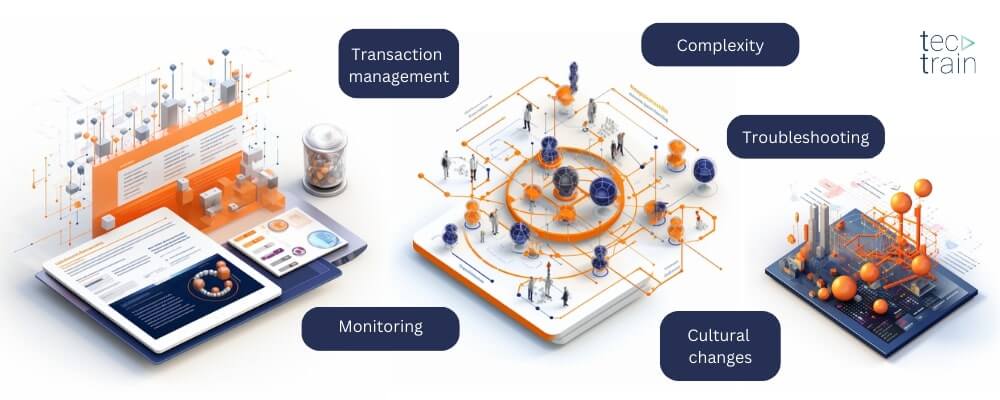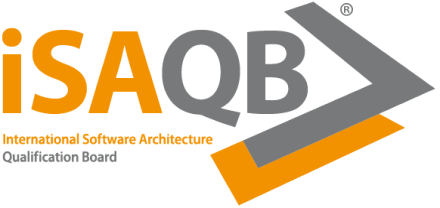Beginner's Guide to Microservices & Software Architecture
In today's fast-paced digital world, crafting a robust and efficient software architecture has become one of the hard parts of technology development.
The challenges lie in managing complex software architecture that not only meets the present needs of companies but also remains flexible and scalable for future requirements. In this regard, microservices have gained significant popularity as an effective architectural approach that addresses these intricate aspects.
Microservices software architecture revolves around the concept of decomposition. Instead of building a monolithic application, it involves breaking down the software into small, independent services. These services collaborate seamlessly to provide the desired functionality, enabling developers to focus on individual components without affecting the entire system. By employing this granular approach, companies can build powerful systems that adapt to changing demands and allow for faster development and deployment cycles.
Understanding microservices is crucial as they play a pivotal role in modern software architecture. Their importance lies in their ability to tackle the complexities of today's software projects effectively. They provide a practical solution for companies striving to achieve flexibility, scalability, and maintainability in their applications. Embracing microservices allows businesses to innovate and respond quickly to market changes, gaining a competitive edge in the industry.
Implementing microservices brings both benefits and challenges to the table. On the positive side, the modularity and independence of services simplify maintenance and updates, leading to faster development and increased productivity. Moreover, microservices enable teams to use different programming languages and technologies for individual services, optimizing each component for its specific task. However, the distributed nature of microservices introduces challenges related to inter-service communication, data consistency, and monitoring.

This guide is for beginners who want to learn about microservices in software architecture. We'll explain what microservices are, why they're important, and how they can be used to build powerful systems. We'll also talk about the benefits and challenges of using microservices and share best practices for implementation.
Before digging into details about microservices you can also check the main topics about software architecture listed below;
- Software Architecture: The Ultimate Guide
- How to become a software architect?
- What Is Component-based Software Architecture?
What are microservices?
Microservices are architectural patterns for developing software applications. It involves breaking down an application into smaller, independent, and loosely coupled services. Each of these services, also known as microservices, is self-contained and has a specific task or function. Microservices are communicated through defined interfaces, usually through APIs (Application Programming Interfaces).
Unlike monolithic architectures where the entire application is developed and deployed as a single unit, microservices allow for a granular separation of functionalities. Each microservice can be developed, deployed, and scaled in its technology. This increases flexibility, and changes made to one microservice do not affect the other services.
Microservices enable development teams to work autonomously as they are responsible for the development and maintenance of a specific microservice. This fosters better teamwork and allows for faster deployment of changes and updates. Additionally, the scalability of individual microservices allows for efficient resource utilization and improved fault tolerance.
Benefits of Microservices
The advantages of microservices include scalability, flexibility, and improved teamwork. They allow for targeted resource allocation to high-demand services, ensuring efficient resource utilization and preventing overload.
Microservices can be independently scaled based on demand, without affecting other parts of the application. This scalability is particularly relevant in handling peak loads, such as during e-commerce sales events or increased data volume in healthcare, ensuring smooth application performance and user experience.
In addition, microservices also offer the following advantages :
1- Facilitated technology diversity and innovation
The use of microservices allows development teams to employ different technologies and frameworks for each service. This promotes technological diversity within the application and enables the use of the best tools for specific tasks. In addition, the flexibility of microservices enables faster adoption of new technologies, thus promoting innovation.
2- Improved teamwork and continuous delivery
Microservices allow responsibility to be shared among smaller, autonomous teams. Each team is accountable for developing and maintaining a particular microservice. This improves collaboration and communication within the team. Additionally, the independent delivery of microservices enables continuous integration and delivery (CI/CD), resulting in faster time-to-market and continuous improvements.

3- Improved scalability and resiliency
Microservices enable granular scaling, where each service can be scaled separately based on current demand. This leads to improved scalability and makes it possible to distribute resources in a targeted manner to the most heavily used microservices. In addition, the division into independent services increases reliability. If a microservice fails, the rest of the application continues to function.
Challenges of Using Microservices
In software architecture, the hard parts often arise when dealing with microservices, despite their numerous benefits. It is crucial to acknowledge these challenges and implement suitable measures to overcome them.
Common challenges include:
- System integration complexity
- Ensuring data consistency and transaction management
- Monitoring and troubleshooting
- Organizational and cultural changes
- Managing version control and deployment

We can examine the topics related to the Challenges of Using Microservices in a little more detail.
System integration complexity: Microservices allow an application to be split into multiple services that need to communicate with each other. This can lead to increased complexity in system integration. It is important to define clear interfaces and communication protocols and to use appropriate tools or middleware to facilitate communication and integration between the microservices.
Data Consistency and Transaction Management: When an action affects multiple microservices and requires data changes across multiple services, ensuring data consistency can be a challenge. Transactions across multiple microservices must be carefully planned and implemented to avoid data inconsistencies. Using eventual consistency models and transaction patterns like the saga pattern can help overcome this challenge.
Monitoring and troubleshooting: As the number of microservices increases, monitoring and troubleshooting become more complex. It can be difficult to keep track of the different services and identify problems. It is important to use appropriate monitoring tools and techniques to monitor microservices' performance, availability, and health. A central logging and monitoring system can help make troubleshooting easier.
Organizational and cultural changes: Microservices adoption often requires changes in organizational structure and culture. Teams need to be able to work autonomously and take ownership of their microservices. Close collaboration between teams and good communication is crucial to face the challenges of organizational and cultural changes.
Version control and deployment management: With a larger number of microservices, version control, and deployment management can become more complex. It is important to establish effective mechanisms for versioning, dependency management, and deployment to ensure changes to the microservices can be made smoothly and consistently.
By being aware of these challenges and employing suitable strategies and tools, the benefits of microservices can be maximized. Careful planning, clear communication, and good collaboration are critical to overcoming the challenges of using microservices and to getting the most out of this architectural pattern.
Best practices in implementing microservices
When implementing microservices, there are best practices that can help ensure the effectiveness and success of the project. Here are some best practices when implementing microservices:
- Domain-Driven Design (DDD): In DDD software architecture, microservices are created by dividing the domain into smaller, related contexts. This ensures focused, independent services that align with business requirements and domain models, leading to a flexible and scalable system.
- API Gateways and Service Discovery: Utilize an API gateway for centralized management and control of communication between microservices. It serves as an entry point for external requests and can handle functions like authentication, authorization, and load balancing. Service discovery tools can be used to discover and manage the addresses of the various microservices automatically.
- Continuous Integration and Continuous Deployment (CI/CD): Implement CI/CD pipelines for automated deployment of changes and updates to microservices. This shortens development cycles and enables continuous application improvement. Automated testing and continuous integration help identify and address issues early on.
- Monitoring and Tracing: Establish an effective monitoring and tracing system to monitor the performance and reliability of microservices. Collect metrics and logs to identify bottlenecks, errors, and undesired behavior. Monitoring tools like Prometheus, Grafana, or ELK stack (Elasticsearch, Logstash, Kibana) can facilitate microservice monitoring.
- Security by Design: Incorporate security into the architecture of microservices from the start. Implement appropriate security measures such as service-level authentication and authorization, encryption of data transmission, and protection against security vulnerabilities like injection attacks or cross-site scripting (XSS).
- Error Handling and Resilience: Due to the independent nature of microservices, it is crucial to implement effective error handling and resilience mechanisms. These may include adding fallback options, implementing circuit breakers, and incorporating retry logic to respond to errors in other microservices.
Conclusion
In summary, microservices enable the development of flexible and scalable software applications by dividing them into independent services. They offer benefits in terms of resource allocation, innovation, teamwork, and deployment. However, challenges related to integration, data consistency, monitoring, and organizational changes need to be managed. By implementing best practices, organizations can overcome these challenges and leverage the advantages of microservices architecture.
For beginners looking to delve into the world of microservices and software architecture, Tectrain offers certification courses through the International Software Architecture Qualification Board (ISAQB). These courses cover the fundamentals of software architecture, with a specific focus on microservices software architecture.
Whether you are new to microservices or aiming to advance your software architecture knowledge, Tectrain's ISAQB certification courses are designed to assist you in learning and growing professionally.
By mastering the intricacies of microservices and software architecture decomposition, you can create scalable, adaptable, and powerful software solutions for the digital age.

Completing the "ISAQB Certified Professional for Software Architecture" certification demonstrates individuals proficiency and expertise in software architecture practices. This certification allows people to showcase their skills and abilities in the field of software architecture. Tectrain's ISAQB certification courses on software architecture are perfect for beginners and experienced practitioners. They help you understand microservices and improve your skills, giving you a chance to advance in your career.
To learn more about the different courses to continue your education as a software architect and find the right one for you, you can discover the iSAQB software architecture modules.









